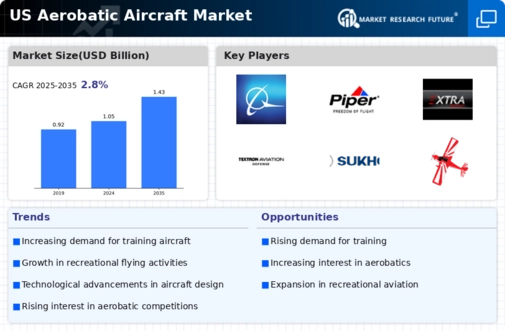Rising Demand for Airshows
Airshows have become a significant driver for the aerobatic aircraft market, as they attract large audiences and showcase the capabilities of aerobatic planes. The US hosts numerous airshows annually, with attendance figures often exceeding 1 million spectators. This growing interest in airshows has led to an increased demand for aerobatic aircraft, as performers and teams require specialized planes to execute complex maneuvers. Additionally, sponsorship opportunities at these events have encouraged more pilots to participate, further stimulating the market. The economic impact of airshows is notable, with estimates indicating that they generate millions of dollars in revenue for local economies. As airshows continue to gain popularity, the aerobatic aircraft market is likely to benefit from heightened visibility and increased sales.
Increased Recreational Flying
The aerobatic aircraft market is experiencing a surge in demand due to the rising popularity of recreational flying among aviation enthusiasts. As more individuals seek thrilling experiences, aerobatic flying offers an exhilarating option. The number of private pilots in the US has increased, with estimates suggesting a growth of approximately 5% annually. This trend indicates a robust interest in aerobatic maneuvers, leading to a higher demand for specialized aircraft. Furthermore, the availability of aerobatic schools and clubs has expanded, providing aspiring pilots with the necessary training and resources. This growth in recreational flying not only boosts sales of aerobatic aircraft but also enhances the overall market landscape, as more individuals engage in aerobatic activities, thereby contributing to the vibrancy of the aerobatic aircraft market.
Growth of Aerobatic Training Schools
The proliferation of aerobatic training schools across the US is a significant driver for the aerobatic aircraft market. These institutions provide aspiring pilots with the necessary skills and knowledge to safely perform aerobatic maneuvers. The number of accredited training programs has increased, reflecting a growing interest in aerobatic flying. As more individuals seek to become proficient in aerobatics, the demand for specialized aircraft rises correspondingly. Training schools often collaborate with aircraft manufacturers to offer tailored programs, which can lead to increased sales of specific models. This symbiotic relationship between training institutions and the aerobatic aircraft market is likely to continue, fostering a new generation of skilled pilots and enhancing market growth.
Increased Investment in Aviation Sports
Investment in aviation sports, particularly aerobatics, is on the rise, contributing positively to the aerobatic aircraft market. Sponsorship from corporations and increased funding for aerobatic teams have created a more robust competitive environment. This influx of capital allows teams to acquire advanced aircraft and participate in more events, thereby elevating the profile of aerobatic flying. Additionally, the growing recognition of aerobatics as a legitimate sport has led to increased media coverage and public interest. As more individuals become aware of aerobatic competitions and their thrilling nature, participation rates are likely to rise, further driving demand for aerobatic aircraft. This trend suggests a promising future for the aerobatic aircraft market as it aligns with broader trends in sports and entertainment.
Technological Innovations in Safety Features
Advancements in safety technologies are becoming increasingly crucial for both manufacturers and pilots. Innovations such as advanced avionics, improved structural integrity, and enhanced emergency systems are being integrated into new aircraft designs. These developments not only improve safety but also attract a broader range of pilots, including those who may have previously been hesitant to engage in aerobatic flying. The introduction of these safety features is expected to drive market growth, as they align with regulatory standards and consumer expectations. Furthermore, the emphasis on safety is likely to enhance the reputation of the aerobatic aircraft market, fostering greater trust among potential buyers and encouraging more individuals to pursue aerobatic training.

















Leave a Comment